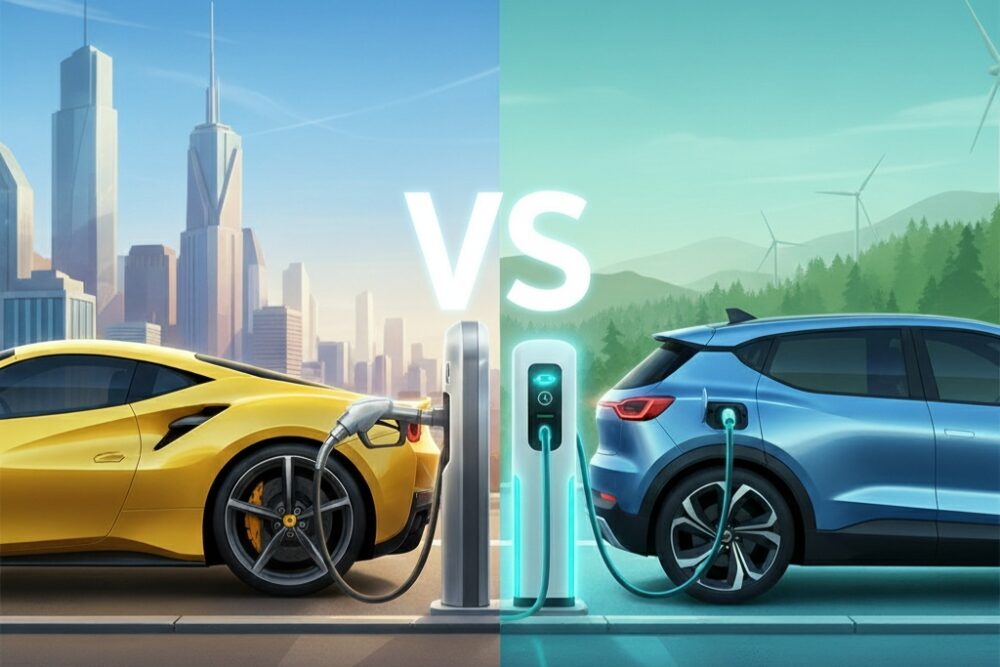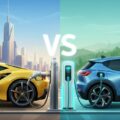Transitioning away from fossil fuels isn’t as simple as flipping a switch. Electric vehicles (EVs) are also moving the pack with zero tailpipe emissions, but it is also associated with a set of challenges. From the environmental impact of mining materials for batteries to relying on electricity that isn’t always clean, the shift to electric power raises questions about sustainability.
E-fuels offer a different path. Made from recycled carbon, these synthetic fuels can be used in current internal combustion engines without the huge changes in infrastructure. They offer a cleaner alternative instead of throwing away millions of gas-powered vehicles that are in use today. Sound intriguing? This blog breaks down the pros and cons of e-fuels vs EVs to help you see where the future of transportation might be headed. Let’s get started!
What Are E-Fuels?
E-fuels (also known as electro-fuels) are man-made liquid fuels that are chemically similar to the gasoline, diesel or jet fuel we use today. The major distinction is the way they are manufactured.
Instead of being refined from fossil crude oil, e-fuels are produced in a complex, high-tech process:
- Electrolysis: Using electricity (ideally from a renewable source like wind or solar), a machine called an electrolyzer splits water (H2O) into its basic components: hydrogen and oxygen.
- Carbon Capture: At the same time, carbon dioxide (CO2) is captured, either from an industrial source or, ideally, filtered directly from the atmosphere.
- Synthesis: The captured hydrogen and CO2 are then combined in a chemical process to create a liquid hydrocarbon fuel.
In theory, this makes e-fuels “carbon-neutral.” The CO2 released when the fuel is burned in an engine is equal to the CO2 sucked out of the air to create it, forming a “closed loop“. Their greatest marketing advantage is that they are a “drop-in” fuel, implying that they can be consumed by the already existing cars, trucks, and planes without adjustment.
What Are EVs?
Electric vehicles (EVs) are a more familiar concept. These are fully electric cars that do not have any internal combustion engine, fuel tank, or exhaust pipe.
They are powered by large, rechargeable battery packs that store energy drawn from the power grid. Their primary advantage is that they produce zero tailpipe emissions. While the electricity they use might be generated from fossil fuels, the car itself is clean, which has a massive impact on air quality in cities. Unlike e-fuels, EVs require a completely new infrastructure of charging stations instead of gas pumps.
MORE ON AUTOMOTIVE INNOVATION
Over-the-Air Updates in EVs: Revolutionizing the Way We Drive
Side-by-Side Comparison
So, are e-fuels better than EVs? At this point, we are going to put these two promising innovations in a head-to-head battle to clearly identify their distinct strengths and weaknesses.

Table 1. E-fuels vs Electric Cars Side-by-Side Comparison
Usability and Infrastructure
This is where the two technologies diverge most.
For e-fuels, the advantage is undeniable convenience. Because they are a “drop-in” fuel, nothing changes for the driver. You use the same car and the same gas stations. The U.S. alone has over 150,000 gas stations, an infrastructure that took a century to build and can be fully repurposed for e-fuels. This makes e-fuels a perfect solution to those who live in rural settings, with limited charging access, and who desire to continue driving classic or performance cars. Refueling takes only five minutes.
For EVs, usability is the greatest hurdle. “Range anxiety” remains a primary concern for new buyers. In fact, a 2023 McKinsey & Company survey found 43% of potential buyers listed it as a major worry. Such anxiety is compounded by the realities of public charging.
Some EV drivers shared their experience of driving an older EV from Philadelphia to Denver, a trip that required 17 charging stops, each lasting 40 minutes to an hour. Even with newer technology, stations can be crowded. Worse, they can be unreliable. A 2022 J.D. Power survey found that 1 in 5 EV owners who visited a public charging station did not charge because the station was malfunctioning or out of service.
MORE ON AUTOMOTIVE INNOVATION
Extended-Range EVs Paving the Way for Change
Cost and Accessibility
Today, you can walk into a dealership and buy an EV. While still more expensive upfront than many gasoline cars, prices are falling, and the market is well-established. The “fuel” (electricity) is also generally cheaper than gasoline.
E-fuels are the opposite. They are currently not available to the public. The world’s first functional e-fuels facility, run by HIF Global in Chile, is a small pilot project that sells its entire output directly to Porsche for its racing and experience programs.
The cost is the single biggest barrier. The production process is so complex and energy-intensive that current estimates put the price at $12 to $15 per gallon. E-fuels will need huge global investments and technological advances in order to achieve “scale effects” and reduce costs to become accessible.
Chris Collins Inc. understands the impact of costs on dealerships. Many people now keep their cars longer rather than upgrading to newer models. Service departments can play a key role in tapping into this trend. Dealers making money from repairs, not just auto sales, is a concept Chris Collins Inc. teaches through Fixed Ops coaching.
Looking for ways to grow your dealership? Contact Chris Collins Inc. to find out how service drive optimization can help.
Public Perception and Adoption
This is where the “carbon-neutral” fuels promise gets complicated.
To begin with, as e-fuels explained, it’s very inefficient to manufacture. Since it requires extensive energy wastage at every stage (electrolysis, synthesis, and then burning it in a highly inefficient engine), an e-fuel car requires approximately five times as much electricity as an EV to go through the same distance. A study in the journal Nature Climate Change found that if you start with 100% renewable energy, only about 10% of it ends up powering an e-fuel car. In contrast, an EV uses about 50% of that original energy.
Second, the “clean” label depends entirely on using 100% renewable energy for production. If e-fuels are made using a grid powered by fossil fuels (like the 2018 German electricity mix), the process creates more than three times the CO2 emissions of simply using conventional diesel.
Third, e-fuels are not zero-emission at the tailpipe. When they burn, they still release air pollutants. Testing by the European think tank Transport & Environment (T&E) showed that cars running on e-fuel emit just as much toxic nitrogen oxides (NOx) as standard gasoline engines and significantly more carbon monoxide and ammonia.
Also Read: Data Risks in Dealerships: Building Client Trust
Future Outlook
The future will likely not be a one-size-fits-all solution. The European Union, for example, is banning the sale of new internal combustion engine cars from 2035. However, following a strong push from Germany, the EU agreed to an exemption for new cars that run exclusively on e-fuels.
This points to the most likely future: a combination of both technologies.
EVs will surely dominate the passenger cars, particularly in urban commuting and in short-haul travel where their extreme efficiency and lack of tailpipe emissions are the most important.
E-fuels, due to their high cost and low efficiency, are not considered a viable large-scale substitute for EVs in road transport. Instead, their future is in sectors that are “difficult to electrify”. E-fuels are indispensable for aviation, cargo shipping, and heavy-duty long-haul trucking, where the high energy density of liquid fuel is essential and batteries are simply too heavy and impractical.
Both technologies offer a pathway away from fossil fuels, but they are likely headed for very different jobs.
Conclusion
Indeed, the race between e-fuels vs EVs is shaping the future of transportation, offering two exciting paths toward cleaner travel. Both offer something different on the table, which is either the established performance of EVs or the technological promise of e-fuels. It is not only about which of them will prevail but how both of these technologies can be united to produce a sustainable solution for all. If this comparison helped you understand more about the topic, share it with others who might find it useful. Helping spread the word means encouraging better choices for a cleaner world. Follow us for more insights!
—
Author: Maverick Steel is a writer and digital marketer who enjoys connecting the dots for strategy and engaging content. He spent 6 years in secondary education as a proud campus journalist, specializing in editorial and column writing. Holding a bachelor’s degree in Marketing Management, Maverick is also a devoted advocate for positive cyber citizenship and a certified pet lover. When he’s not busy writing, you can catch him hitting the gym or enjoying a matcha latte at the nearest aesthetic coffee shop.






